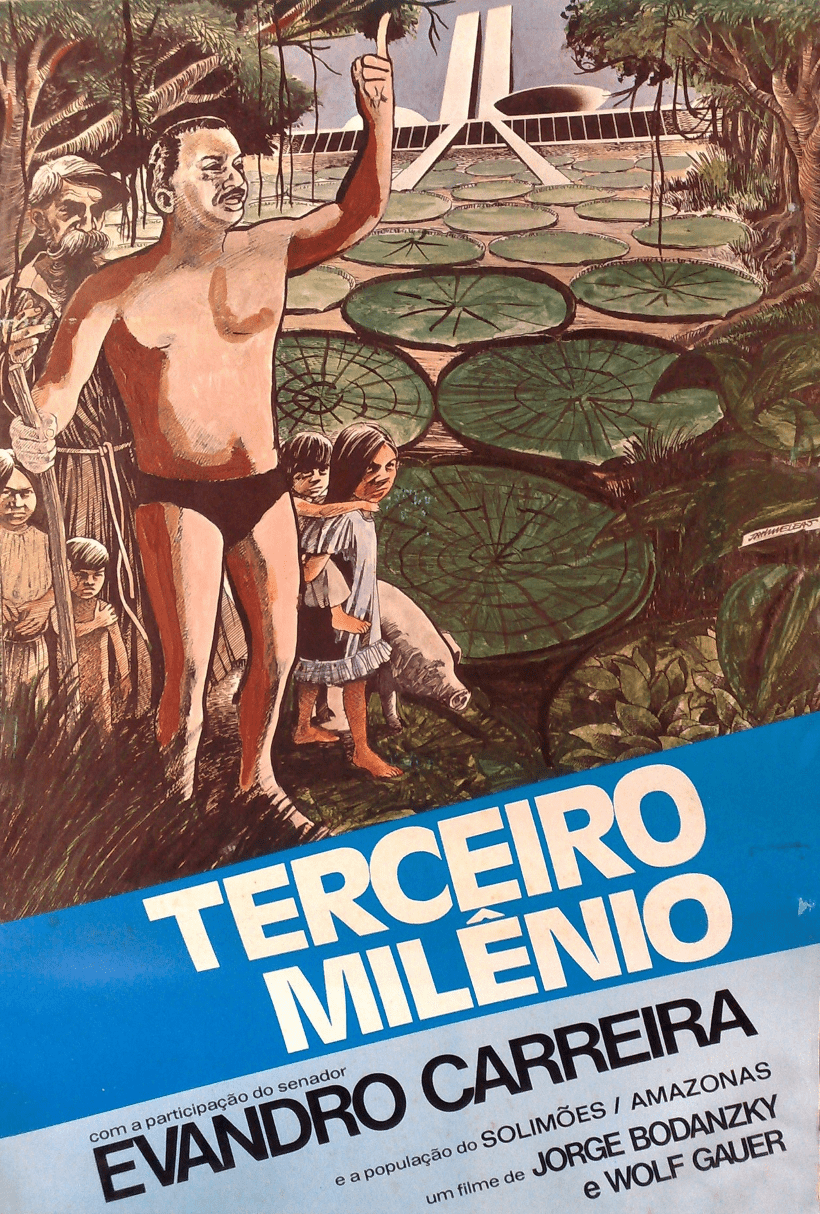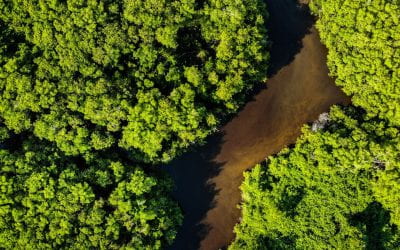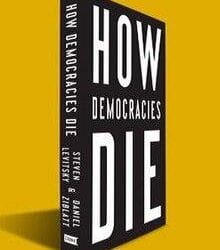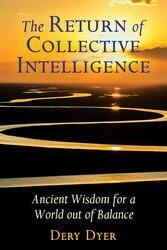The Third Millennium: Jorge Bodanzky’s Delirious and Prescient Amazonian Message
Images of bulldozers felling large trees appear on the screen. With a heroic soundtrack in the background and narration in an epic tone, the voice over declares, “the revolution comes to the jungle.” The color footage is from a 1971 Brazilian newsreel about the construction of the Trans-Amazonian Highway. The narrator celebrates the inauguration of a “new history” for Amazonia that would erase the saci-pererês, iaras and cobras-grandes, key-figures of indigenous mythologies, without once mentioning indigenous peoples whose land the government was claiming to settle the region. He continues by noting that this “magical thinking” would be replaced by the “magic of development.”
The newsreels were produced by the Agência Nacional, founded in 1945 to provide and distribute official news, radio programs and films tackling issues deemed of national interest. During the military dictatorship (1964-85), several newsreels presented the government plans to develop the Amazon and “integrate the region into the nation,” with special editions dedicated to the Trans-Amazonian Highway, the regime’s most ambitious plan. The newsreels were shown in movie theaters across the country. When I started researching the Brazilian cultural production about Amazonia between the 1950s and the early 1980s, I was intrigued by what I felt was a mismatch between the importance of the region for developmentalism since the postwar and its seeming absence from artistic and literary realms. I was particularly struck by the lack of feature-length films on Amazonia during most of the military dictatorship.
The majority of Brazilian films made between the 1950s and the 1980s focused either on rural life in the Northeast or urban environment of the Southeast, including the commercial films produced by short-lived company Vera Cruz, the state-sponsored films of Embrafilme, and the avant-garde production of Cinema Novo and Cinema Marginal. Concerns about national formation and identity, development and underdevelopment were central to Brazilian social thought and culture of the time, as film scholar and critic Ismail Xavier has pointed out. The most innovative filmic production of the period engaged those same issues (See Allegories of Underdevelopment: Aesthetics and Politics in Modern Brazilian Cinema. University of Minnesota Press, 1997). Strikingly, Amazonia, which was central to the project of national-developmentalism, is all but absent of these films. This is even more intriguing given the government’s investment in producing audiovisual materials about Amazonia.
In the past few decades, a spate of films about Amazonia made increasingly in collaboration with or entirely by Amazonians, indigenous peoples included, have changed the outlook of Brazilian cinema. However, when Brazilian filmmaker Jorge Bodanzky made Iracema, uma transa amazônica in 1974, it was a watershed. The “docu-ficção,” that is, a hybrid film that combines fictional and documentary strategies, became an emblem of Brazilian experimental film. Most critics saw it as a scathing picture of the Brazilian nation under the dictatorship, drawing on and departing from the Romantic imaginary forged in José de Alencar’s 1865 novel Iracema: lenda do Ceará. Yet the film also shows the consequences of developmentalist policies in Amazonia, questioning Brazil’s modernizing premises, and is a document of emerging environmental awareness.
The now-classic Iracema was Bodanzky’s first feature-length film, co-directed with Orlando Senna. He has since dedicated most of his career to filming in Amazonia. However, none of these films has reached a wider audience. One of them is Terceiro Milênio(Third Millenium 1980), co-directed with Bodanzky’s German partner Wolf Gauer. The film is both a documentary of the complex situation of Amazonia in the early 1980s and of imaginative and alternative ways of thinking about the region’s socio- and biodiversity, as well as its role in the creation of a future for the planet. If it is true that the lack of commercial distribution has stopped the film from having more impact, its marginal place in the history of Brazilian cinema also shows how even as filmmakers in the region developed a political and experimental filmic language, Amazonia was not an appealing subject for artists until recently. Of course, the region has been exhaustively painted since colonial times and with the invention of photography and film the visual appeal of the Amazon became clear. There were many films about Amazonia in the first half of the 20th century, but not in the period in which it was at the spotlight of a megalomaniac developmentalist project and coincidentally (or not) when large swaths of forest were being destroyed and indigenous peoples were either displaced or killed.
Terceiro Milênio follows former Amazonas State Senator Evandro Carreira (1927-2015) on a political rally along the Solimões river. Carreira and a small crew set sail on a boat down the river from Tabatinga — where the borders of Brazil, Peru and Colombia meet — to the capital of the state Manaus. On the way, they visit the Maiuruna and the Ticuna peoples, talk to a group of loggers, FUNAI (Fundação Nacional do Índio) agents, caboclos, indigenists, activists and social workers. They also filmed an ultraconservative religious community led by the missionary José da Cruz (1913-1982), the Ordem Cruzada Católica, Apostólica e Evangélica, which gathered more than 30,000 indigenous people. The seriousness of the issues at stake notwithstanding, Terceiro Milênio is a delirious “no-road movie,” traveling rivers rather than roads. Carreira’s flamboyant eccentricity gives fictional tones to the character, so much so that many people who watched it at the time would ask if Carreira was, in fact, an actor hired for the part.
According to Bodanzky, he gave the film its title because he realized then that Carreira’s prescient ideas about Amazonia would only be understood in the third millennium. Drawing from the field of ecological economics and the writings of Amazonian intellectuals such as Ramayana de Chevalier (1909-1972), Carreira underscored the centrality of water to the Amazonian biome and culture. But beyond his laudatory speeches about the “hydro-Medusa,” he insisted on the role of Amazonia, and particularly Amazonas, Brazil’s largest state, in what he termed as “a new Copernican Revolution.” Just as Copernicus revealed that the Earth was not the center of the universe, Carreira urged humans to understand their true place within the planet (Recado amazônico. Senado Federal Centro Gráfico, 1975, p. 20). In this, he resonates with the ethics of planetary stewardship defended by ecologists.
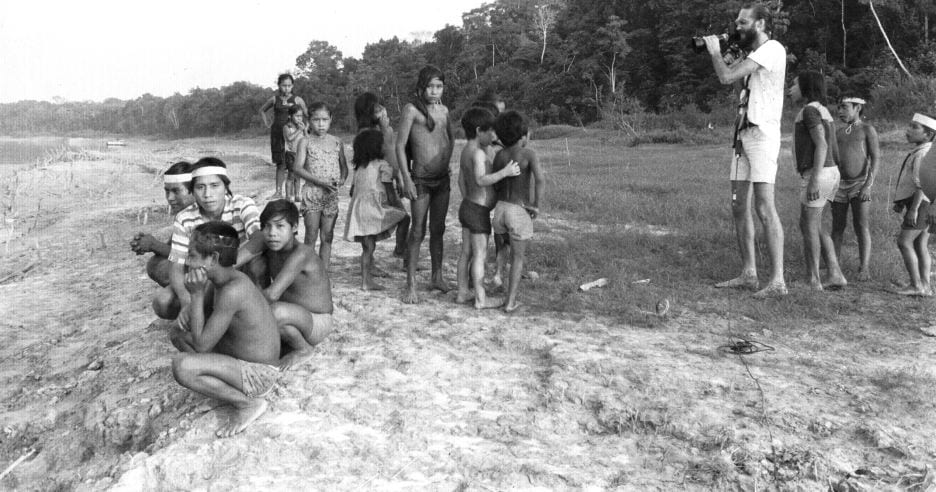
Jorge Bodanzky filming the Maiuruna people for Terceiro Milênio, 1980. Collection of Jorge Bodanzky / IMS Instituto Moreira Salles
Carreira had chaired a parliamentary proceeding in 1979 to investigate the devastation of the Amazon forest and its ecological and social implications. He was against projects to develop Amazonia centered on large monocultural plantations or cattle ranches, as well as predatory exploitation of resources. In the 1970s, economists and planners around the globe were concerned about the exponential growth of population and the means to feed this population. While some saw in this an excuse for infinite growth counting on technology to mitigate environmental degradation, the period also witnessed a shift in the human vision of nature. Throughout the 1970s, popular demonstrations for environmental reforms and the foundation of the first green parties, among other things, called into question the developmentalist consensus.
In Brazil, however, the military positioned environmental protection as an enemy of progress. At the first Conference of the United Nations on the Human Environment held in Stockholm in 1972, Brazilian delegates stood against environmental regulation, arguing that it would slow down the march of developing countries toward industrialization (Antoine Acker, Volkswagen in the Amazon: The Tragedy of Global Development in Modern Brazil. Cambridge University Press, 2017, p. 114). At the same time, as political scientists Kathryn Hochstetler and Margaret E. Keck have shown, the left was too conservative in terms of ecological ideas even as Brazilian society showed increasing interest in the topic and environmental movements became organized in the wake of social movements’ struggle against the authoritarian regime (Greening Brazil: Environmental Activism in State and Society. Duke University Press, 2007). Carreira stood out in his critique of developmentalism, defending instead a more sustainable development, which included extractive activities that were less harmful to the forest.
But if ecology was sort of countercultural then, today it is increasingly relevant for the sciences. The importance of Amazonia for the Earth’s carbon balance cannot be overstated. In 2019, Princeton University scientists modeled the climate impacts of replacing the Amazon forest with cattle ranches. The results are dire for the global climate. Furthermore, Brazilian scientist Antonio Nobre, a senior researcher at the National Institute for Space Research (INPE), has been stressing the Amazon region’s impact on the global water cycle due to its extraordinary flying rivers, whose implications for rain and humidity extends to the whole world. His brother, the Brazilian climate scientist Carlos Nobre, developed a proposal for a new model of sustainable development in the Amazon that relies on preserving the forest and valuing the assets of biodiversity with the aid of cutting-edge technology. When Carreira defended something of the sort in Brasília, his peers at the senate laughed at him as captured by Bodanzky’s camera.

The Ordem Cruzada Católica, Apostólica e Evangélica, 1980. Collection of Jorge Bodanzky / IMS Instituto Moreira Salles
At the same time, the title resonates with Carreira’s own messianic ideas and rhetoric—in his book Recado Amazônico (Amazonian Message, 1975) he posits his projects for Amazonia as a mission—while referencing the long history of messianism associated with Amazonia, of which Cruz’s missionary community is but one example. The first contact of the Ticuna with Spanish Jesuits dates from the 17th century, resulting in the establishment of several missions in the region of the Solimões river. That same century, the Portuguese Jesuit priest Antonio Vieira spent many years in Brazil, coordinating religious missions in the provinces of Maranhão and Grão-Pará. Vieira wrote his first futurological treatise Esperanças de Portugal, V Império do Mundo in 1659, while he was in the Amazon. He poses the role of Portugal, more than any other nation, to advance into the non-Christian world and convert souls to the Catholic Church. The millenarian fifth and last empire would lead to the Last Judgment and to the end of history.
Millenarianism has a complex history. Vieira, for instance, advocated against the slavery of indigenous peoples, while working hard towards converting them to Catholicism. But anthropologists have also shown how indigenous peoples always negotiated the encounter with missionaries and indigenists. Ticuna mythology, for instance, was rife with messianic and eschatological ideas.
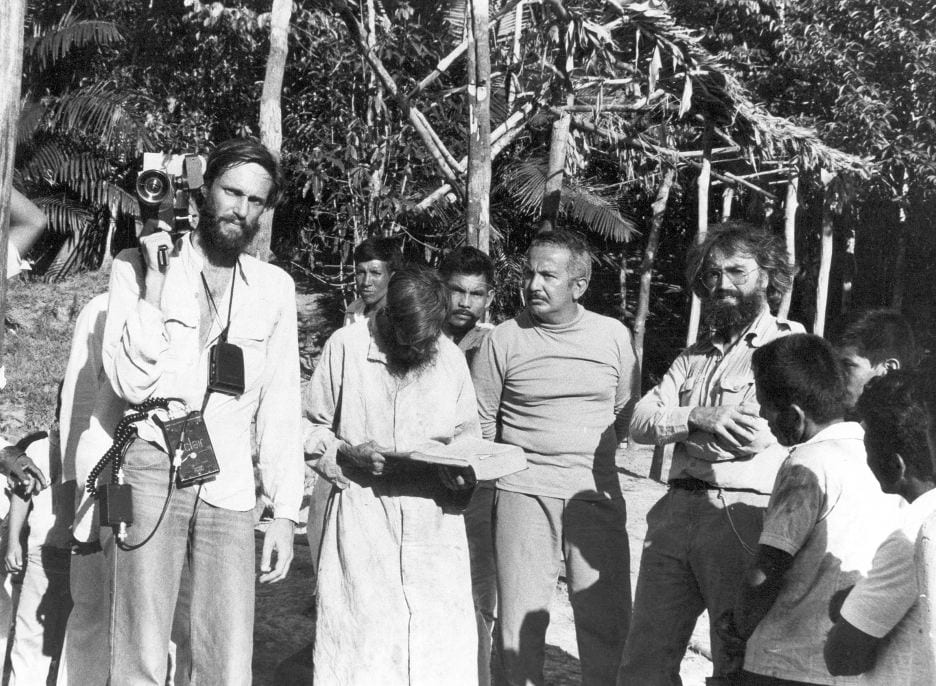
Jorge Bodanzky, José da Cruz, Evandro Carreira and Wolf Gauer at the Ordem Cruzada Católica, Apostólica e Evangélica, 1980. Collection of Jorge Bodanzky / IMS Instituto Moreira Salles
Nevertheless, most religious missions depended upon the de-indianization of Amerindians, that is, they imposed exogenous beliefs and ways of living that sought to get rid of indigenous difference. For instance, Vieira’s project relied on the incorporation of the gentiles to the body of the church, which presupposed that they overcome their “gentile state” as the condition upon which relied the salvation of their souls. In an analogous way, indigenist policies under the dictatorship sought to integrate indigenous peoples “into the national community,” as the Estatuto do Índio passed in 1973 posited. Carreira’s mission trafficked the opposite direction. To him, it was precisely indigeneity, namely indigenous people’s non-dichotomic relationship to nature, that was responsible for preserving Amazonia’s biodiversity for centuries. While messianic leaders or state employees relied upon de-indianization premises, Carreira, who self-identifies as a caboclo, proposed to take Amazonia and Amazonians as the model for a new world.
The film, however, is far from adhering uncritically to Carreira’s messianism. In the final sequence, Carreira is filmed in the forest, almost in a state of trance. He mounts a small hill close to a lake full of vitórias-régias (giant Amazonian water lilies), wearing a colorful and patterned speedo, and starts delivering a discourse as if he were preaching. While Carreira is at times prescient, his discourse is not free from falling into colonial clichés about Amazonia, as when he compares the forest to a virgin woman. And then he grotesquely adds that she should not be raped, but “deflorated with affection,” the archaism of the term revealing the long history of violence embedded in the history of colonialism, religious missions and hetero-patriarchalism.
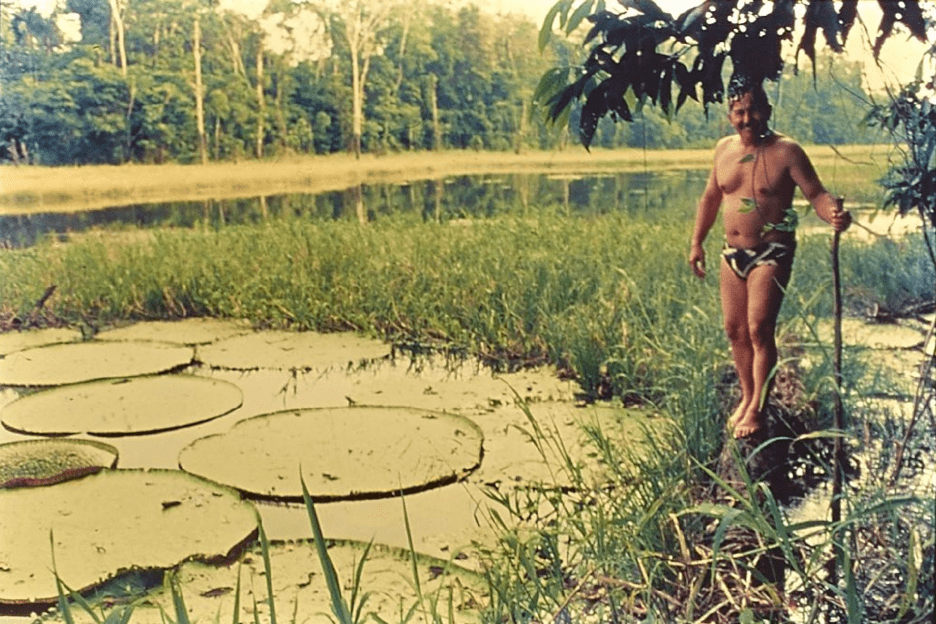
Evandro Carreira during the shooting of Terceiro Milênio, 1980. Collection of Jorge Bodanzky / IMS Instituto Moreira Salles
Thirty years after filming Terceiro Milênio, Bodanzky went back to the upper Solimões to take part in a workshop to discuss audiovisual techniques with the Ticuna people. In De volta ao Terceiro Milênio(Back to the Third Millennium, 2006), the Ticuna watch the 1980 film, laughing at many passages, while also making amendments to the stories told in the film. The Ticuna criticize José da Cruz’s mission, which had all but exterminated their language and culture. Yet they seem to admire Carreira, despite his eventual patronizing manners. Only the final soliloquy about “defloration” deserves a rebuff from an indigenous woman, who reacts to his language saying, “But this is rape!” As indigenous people increasingly join the conversation, they point the limits of both religious missions and developmentalism, contributing to alternative ways of thinking about the planet and the very possibility of a future for humans on this planet. A case in point is indigenous activist and thinker Ailton Krenak’s book advancing some ideas to postpone the end of the world (Idéias para adiar o fim do mundo, Companhia das Letras, 2019).

Wolf Gauer, Evandro Carreira and Jorge Bodanzky at the Senator’s office in Brasília. Behind them, a painting depicting a view of Amazonia. The painting, according to Carreira, helps him deal with a longing for Amazonia while he is in Brasília, which he defines as a “cemetery of souls.”
In the 1970s, Carreira struck Bodanzky as a visionary, since his views about Amazonia were different from the mainstream and official plans for the region. Yet the film remains notably urgent today. Since Jair Bolsonaro took office in 2019, he has not only brought back the military into the government but has also consistently overturned important democratic achievements, including the demarcation of indigenous territories and environmental regulation. The current government’s projects for the Amazon are uncannily similar to those of the dictatorship, including in the use of language. As a result, deforestation, as well as violence against indigenous peoples and human rights activists have scaled up to alarming rates. It is well past time to start thinking about the third millennium.
Spring/Summer 2020, Volume XIX, Number 3
Marina Bedran is an assistant professor of Modern and Contemporary Lusophone Literatures and Cultures in the Department of Modern Languages and Literatures at Johns Hopkins University, beginning in Fall 2020. She is completing a Ph.D. in Spanish and Portuguese at Princeton University (expected July 2020).
Related Articles
Amazon: Editor’s Letter
The Amazon is burning. The trees that have not been cut down are on fire. The crisis is now. When I began to work on this issue on the Amazon, that was pretty much my vision, and it was a real one. I was determined to make the magazine on the Amazon about…
How Democracies Die
How Democracies Die analyzes the main dangers that modern democracies face. As the authors warn, 21st-century democracies do not die in one fell swoop, in a violent way, by hands that do not always belong to the political system. On the contrary, modern democracies…
The Return of Collective Intelligence
My college Native American Culture professor, the Mescalero Apache scholar Inez Sánchez, told our class that we should regard the word “primitive” as synonymous with “complex.” I gained a better understanding of what Sánchez meant reading The Return of Collective…

